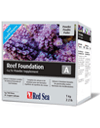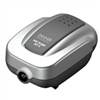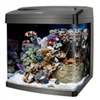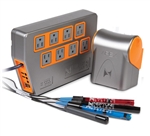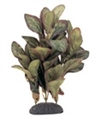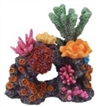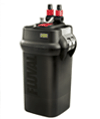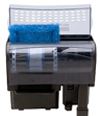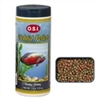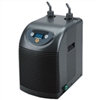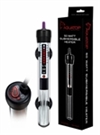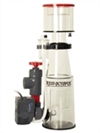Aquarium Filtration Overview
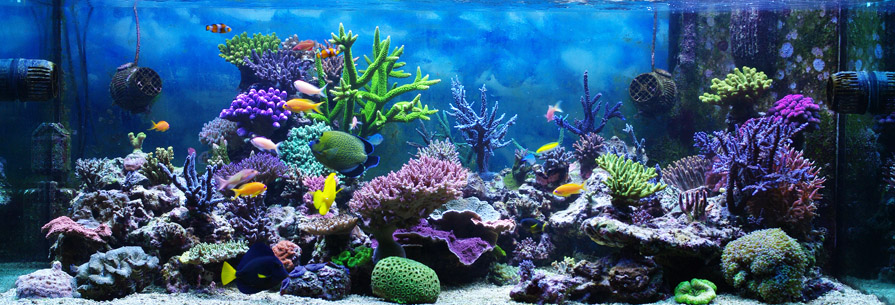
This article is our main filtration article, and it covers a great many topics and also links to a variety of other articles and videos that will help explain the various subjects. The article begins with the recommended equipment for reef aquariums, saltwater fish-only aquariums, and freshwater aquarium filtration. The article then explains the theory behind filtration (mechanical, chemical & biological), and explains why you should use protein skimmers, canister filters, wavemakers, algae filtration, UV sterilizers, organic carbon dosing, and other equipment in specific situations.
REEF AQUARIUM FILTRATION
Use the following equipment:
Filtration in a reef tank is best done with living bacteria on rocks, sand, and biological filter media, a
protein skimmer, and
activated carbon.
In addition, you will want some way to manage the nitrate and phosphate in the aquarium. There are three ways we have found to manage nitrate and phosphate in a reef aquarium.
1. Frequent sizeable water changes. At least 1/4th of the aquarium weekly.
2. Algae filtration. This can be done with an
algae turf scrubber,
refugium, or
algae reactor.
3. Bacterial Filtration: With a
biopellet reactor, or daily organic carbon dosing with a product such as
Reef BioFuel.
The total pumping capacity of all the pumps and powerheads, not including the protein skimmer pump, should turn the water over at least 20 times per hour.
A wavemaker will improve your filtration by creating varied water movements that will better stir up trapped debris.
We sell a couple of different dedicated
wavemakers. Most people these days are using
controllable pumps and gyre generators to create this varied water movement.
SALTWATER FISH-ONLY AQUARIUM FILTRATION
Use the following equipment:
Systems under 50 gallons can use a
Seachem Tidal,
Penguin BIO-Wheel, or
AquaClear Power Filter hang on the back filter.
Systems over 50 gallons can use a
NuClear Canister Filter. These filters will require that you have a way of getting the water out of the tank using a plumbed through the bottom tank.
Instead of the NuClear, you could use a
Fluval Canister Filter for a tank over 50 gallons. This filter includes the pump and plumbing and are relatively easy to set up. The filter either come with or can be purchased with biological and chemical filtration media as well as mechanical filter media.
The total flow of all the pumps should turn the tank over 3-5 times per hour.
A wavemaker will improve your filtration by creating varied water movements that will better stir up trapped debris.
We sell a couple of different dedicated
wavemakers. Most people these days are using
controllable pumps and gyre generators to create this varied water movement.
FRESHWATER AQUARIUM FILTRATION
Use the following equipment:
Systems under 50 gallons can use a
Seachem Tidal,
Penguin BIO-Wheel, or
AquaClear Power Filter hang on the back filter.
Systems over 50 gallons can use a
NuClear Canister Filter. These filters will require that you have a way of getting the water out of the tank using a plumbed through the bottom tank.
Instead of the NuClear you could use a
Fluval Canister Filter for a tank over 50 gallons. This filter includes the pump and plumbing and is relatively easy to set up. The filter either comes with or can be purchased with biological and chemical filtration media as well as mechanical filter media.
The total flow of all the pumps should turn the tank over 3-5 times per hour.
A wavemaker will improve your filtration by creating varied water movements that will better stir up trapped debris.
We sell a couple of different dedicated
wavemakers. Most people these days are using
controllable pumps and gyre generators to create this varied water movement.
AQUARIUM FILTRATION THEORY
Aquariums are small bodies of water with a greater density of organisms than real environments—leading to the build-up of waste products to toxic levels. Filtration removes these unwanted compounds from the tank's water—making the environment more suitable for keeping corals, fish, invertebrates, and any other life forms that you may be planning to add to your aquarium.
All aquariums require biological, mechanical, and chemical filtration. Each of these types of filtration requires different methods for reef tanks, saltwater fish-only tanks, and freshwater tanks. Below is a general guide to help you decide which products you need for your aquarium.
ABOUT BIOLOGICAL AQUARIUM FILTRATIONBiological filtration deals with the removal of nitrogen breakdown by-products from the water. These nitrogen compounds appear in the tank as a result of the animals added to the tank; the food that is added to the tank, the algae that die off, and the respiration and metabolism of the fish and invertebrates. Even though the water quality is usually excellent when an aquarium is first started up, as soon as animals are added the water quality starts deteriorating quickly. Biological filtration counteracts these negative effects and removes whatever noxious compounds may have been added to the water as a result of populating the tank, feeding the animals, biochemical activity taking place, etc. Biological filtration is best done with live rock, live sand, or biological media.
Biological filtration has four goals:
1. removal of nitrogen breakdown products, such as ammonia and ammonium
2. conversion of ammonia to nitrite
3. conversion of nitrite to nitrate
4. removal of some of the nitrate from the system
Bacteria is used to eliminate ammonia and nitrite. Ammonia present in the water is broken down to nitrite by a form of bacteria called Nitrosomonas. These bacteria appear spontaneously, or their proliferation can be sped up by the addition of a batch of seeded gravel or rock from another tank. Seeded gravel is gravel, or rock, that comes from an aquarium that has been running for a while, and already has a great deal of bacterial life. Transferring some of the gravel (rock, coral pieces) also transfers bacteria. Ammonia tests should always show zero mg/l, or ppm. Even small amounts are unacceptable in reef systems, as they will definitely harm fish and invertebrates alike.
Nitrite must also be removed. Nitrobacter species appear spontaneously in tanks and convert the nitrite to nitrate, a compound that is less damaging. Should nitrite tests of the aquarium water show the presence of merely low amounts of nitrite, such still is an indication that somewhere in the aquarium, or in the filters, the natural breakdown cycle has been, or is being, interfered with. The hobbyist should immediately determine where this interference is coming from and remedy the situation. This may entail cleaning all mechanical filters, ensuring that the gravel or substrate is clean and does not harbor trapped detritus and other organic matter, removing dead or dying algae, checking the cleanliness of corner overflow boxes and/or surface skimming siphons, etc. The presence of nitrite may also suggest that you are feeding too much or the tank is overloaded to such a degree that the filters can no longer deal efficiently with that biological load. This should prompt the removal of livestock, or the increase of the filter capacity by adding additional biological filtration.
Nitrates are another problem altogether. Traditionally nitrate has been regarded as a compound that is not harmful. Such may be the case in fish-only tanks, but it is not so in today's living reef aquariums. Nitrate is definitely a pollutant, and it does affect the well-being and appearance of corals and other invertebrates. More important to most aquarists. Elevated levels of nitrate can lead to excessive algae growth.
Further Reading:
Live Rock and Live Sand For Reef Tanks
For reef aquariums, using live rock and live sand are the best methods of biological filtration. MarineandReef.com does not sell live rock or live sand. It's best to purchase these products locally.
How Does Live Rock Perform Biological Filtration?
1. Live rock immediately introduces into the aquarium numerous algae, bacteria, and small invertebrates—all of which contribute to the overall quality of the aquarium water.
2. Ammonia, nitrate, and phosphate are readily assimilated by algae and photosynthetic corals growing on and in the rock.
3. Ammonia can also be quickly converted into nitrate by the bacteria on and in the rock.
4. This nitrate can be either absorbed by the algae and corals, or it can be denitrified by bacteria in close proximity to the nitrate-producing bacteria.
At the same time, live rock enhances the look of the aquarium and provides shelter for the inhabitants.
Canister Filters & Power Filters
Fish-only saltwater and freshwater tanks might use a mechanical aquarium filter to perform biological filtration as many of these filters have a small area for extra biological filter media.
Mechanical filters, such as canister filters and power filters, are containers that usually have filter pads/media and often have some sort of filter media, such as a biological filter pad or bio balls. The mechanical filter pad traps waste, which needs to be periodically washed off the filter pad. With some canister filters, such as the
Nu-Clear Model 547 Canister Filter, all of the media is biological media. When using filters such as the Nu-Clear 547, you would want to use a mechanical filter in line before the biological filter. For freshwater or saltwater fish-only tanks over 100, you'll definitely want to use one or more
Nu-Clear Canister Filters (and for tanks from 50 to 100 gallons you might still want to use one). The Nu-Clear brand will take some knowledge of plumbing to set up as they need to be used with plumbed-through-the-bottom tanks or with an over-the-back overflow box.
For smaller tanks and for simpler installations you will want to use the
AquaClear Power Filter or
Fluval Canister Filter, all of which have some sort of biological filtration.
Algae Filtration
Algae filtration in the form of a
refugium,
macro algae reactor, or
algae turf scrubber is a method of purifying aquarium water by growing algae. As mentioned earlier high nitrate levels can lead to excessive algae growth. This is because algae uses nitrate as a fertilizer. The algae strips the nitrate from the water and incorporates it into it’s tissue as it grows. When the algae grows in the main aquarium this is very ugly and unwanted. Devices such as refugiums, macro algae reactors, and turf scrubbers are designed to grow algae outside the main display so that the algae can take the nitrate out of the water column while preserving the attractive algae free display that we all like.
In saltwater and reef aquariums, refugiums and macro algae reactors grow seaweed-like algae such as Chaetomorpha. A small portion of this algae is purchased from a livestock vendor and then added to the reactor or refugium. A light is directed at algae and the algae grows. Once the algae completely fills the chamber, a portion is removed and discarded to allow for more algae to grow.
With an algae turf scrubber, a plastic sheet has water poured over it and is lit from both sides. This environment attracts turf algae which is a natural algae that enters the aquarium like most pest algaes do, seemingly from nowhere but really from hitchhiking on fish, plants, and corals. The turf algae grows on the plastic sheet and the sheet is periodically cleaned to remove the algae and allow room for more algae to grow. Turf scrubbers can work in both freshwater and saltwater aquariums.
Organic Carbon Dosing
Organic carbon dosing is a form of bacterial filtration designed to remove nitrate from the aquarium water. In a healthy mature aquarium, enough natural bacteria will grow that Ammonia and Nitrite levels should be stable at 0ppm. This not the case with Nitrate levels. The reason is that the bacteria that remove nitrate from the water cannot proliferate because they are running out of something they need. In most cases what is missing is Organic Carbon. When the bacteria run out of organic carbon they stop proliferating and stop removing Nitrate from the water. Organic carbon dosing is the process of adding the needed organic carbon back into the aquarium so that the natural bacteria can continue to remove nitrate.
It is important to note that Organic Carbon is not the same thing as the Activated Carbon that is used as a form of chemical filtration. Activated Carbon is not in a form that the nitrate-reducing bacteria can use so it does not help reduce nitrate.
Organic Carbon dosing can be done by daily additions of a liquid like Brightwell’s Reef BioFuel, or using a media reactor with Bio-Pellets. Carbon dosing can work in freshwater aquariums but it is far more common in saltwater and reef aquariums.
Further Reading:
Longer article on
Organic Carbon DosingABOUT CHEMICAL FILTRATION
Activated Carbon
Chemical filtration is most commonly accomplished by means of activated carbon. The carbon's micro-porous structure absorbs dissolved organics, chloramines, fish odors, toxic metals, toxic gases, and growth-inhibiting enzymes. We carry the
Inland Seas, Marineland, and Acurel activated carbon.
Tips for using activated carbon:
1. MAKE SURE IT IS ACTIVATED CARBON. Many types of carbon are sold in pet stores. For a reef aquarium you need carbon that has been activated—a process that substantially increases the porosity of the carbon, and as a result greatly increases the total active surface area, allowing it to be much more effective at absorbing compounds that need to be removed from the tank's water.
2. FLOW WATER THROUGH, NOT OVER. Your activated carbon will work much better if water is actually forced to go through the amount used, rather than just flowed by and over it. More contact between the activated carbon and the water obviously results in a more efficient cleansing process.
3. REPLACE YOUR CARBON. Activated carbon has a maximum adsorption capacity, which is the reason that it should be replaced from time to time. How frequently is hard to determine, because it is dependent on the quality of the water that is flowed through the carbon. As a general rule replace carbon monthly.
4. MAKE SURE CARBON IS NOT TUMBLING. Carbon that is constantly tumbling or grinding together will deteriorate into dust. This carbon dust is known to harm fish and cause lateral line erosion.
Phosphate & Nitrate Removers
Besides activated carbon, a wide variety of resins, minerals, and other media have been employed by aquarists in an effort to remove either specific ions like phosphate or a wide range of largely unidentified substances from aquarium water.
Two Little Fishies PhosBan can be used by itself to remove phosphate, or it can be used in the
Two Little Fishies PhosBan Reactor.
Media Bags
Boyds Chemi-Pure and
Chemi-Pure Elite come pre-bagged inside the jar. All other products need to be bagged using one of the
Acurel Media Bags. All bags have ties sewn into the top for easy closure.
Poly-Bio-Marine Poly Filters
The
Poly-Bio-Marine Poly Filters are pads that absorb and adsorb contaminants and other toxic materials that are found in nature or added to fresh and salt water with or without fish and invertebrates. Medication added to aquariums for treatment of diseased fish will automatically be removed by the Poly Filter (after serving their intended purpose). The pads are placed in any filter in a place where chemical filtration media is intended (generally, after the larger sediment has been filtered out).
ABOUT MECHANICAL AQUARIUM FILTRATION
Mechanical Filtration is the removal of unwanted particulate matter from an aquarium by trapping it in a dedicated location, such as a filter pad, which must be cleaned periodically. The key to this is the cleaning. A mechanical filter is useless unless it is cleaned.
Mechanical filtration is recommended for all freshwater tanks and saltwater fish-only tanks. Because reef aquariums are very delicate and require cleaner water, we recommend using a protein skimmer instead of or in addition to a mechanical filter with a reef aquarium. Protein skimmers are also recommended for use with saltwater fish-only tanks. They cannot be used with freshwater tanks because protein skimmers require saltwater.
Keep in mind that mechanical filtration:
- does not directly remove dissolved ammonia
- does not remove microscopic bacteria and algae from the water
- does not remove any solids trapped by gravel, plants, or decorations
Many mechanical filters also perform the functions of biological and chemical filtration if special filters are used for those functions.
There are three basic types of mechanical aquarium filters:
1.
Protein Skimmers (for saltwater tanks)
Protein skimmers are not always listed as a method of mechanical filtration (perhaps because they work very differently than canister and power filters), but it is the best form of mechanical filtration for any saltwater reef or fish-only tank. Protein skimming is a process analogous to the production of sea foam. The motion created inside the skimmer injects air bubbles into the aquarium water, creating a foam on which organic molecules collect at the air-water interfaces of the bubbles. This foam is captured in the collection cup and disposed of. For decades It was the only method that actually removes dissolved organic compounds from the tank before they break down into toxic ammonia and nitrite compounds.
2.
Canister Filters (for freshwater and saltwater fish-only tanks)
With a canister aquarium filter water is pumped at moderate pressure through a filter media, such as a micron filter cartridge. The waste in the water is trapped by the filter media. Canister filters are especially useful in aquaria with large or numerous messy eaters that generate a lot of waste.
For these filters to be effective they must be frequently cleaned to avoid the decomposition of waste in the water stream. Clean the filter(s) at least once a month. (As noted above, you should not use a canister filter for a reef tank). Cleaning the canister filter media involves removing all the material that you placed inside, except biological filtration material, and rinsing it thoroughly in fresh water before placing it back in the canister. These filters usually sit in a cabinet below the aquarium, or on the ground next to the aquarium.
In order to make the cleaning process as easy as possible, it is suggested that you use quick disconnect shut-off valves on either side of the canister filter. This will allow you to take the canister filter out of service without having to worry about water spillage, except for the very little water that is between the canister and the quick disconnect valves.
Some filters use some form of pleated cartridge, or pleated device, to increase the amount of surface area through which the water can flow and be filtered. The more surface area, the more particles the filter can collect before needing cleaning. Cleaning is a little more involved, as these cartridges usually need to be bleached to remove the accumulated detritus. This takes more time and requires that you make sure all the bleach is removed, before putting the cartridges, or other material, back in the canisters. It is, actually, a good idea to have an extra pleated cartridge around. Because of the way they need to be cleaned, the pleated cartridges will wear out.
Some units come with pressure gauges. This allows you to determine when it is necessary to clean the cartridge based on what the manufacturer suggests. Increased levels of pressure inside the canister are an indication that it is plugged, and needs cleaning.
Marineandreef.com carries four brands of canister aquarium filters, which can be separated into two distinct categories:
The
Inland Seas Nuclear Canister Filters are for tanks from 50 to 90 gallons. These filters are commonly used by professional aquarium service companies and for commercial locations. By using multiple filters in series or parallel, or by using the Nu-Clear Extension Kit, these filters can provide filtration for tanks much larger (i.e. four filters for a 360 gallon tank). The Nu-Clear filter comes without a self priming pump and must be used with a plumbed through the bottom tank or with an over the back overflow box.
The more common type of canister filter is the Fluval, OASE, and Aqueon style filter. These filters come complete with a pump and plumbing equipment and can easily be hooked up over the back of any aquarium (without an overflow box or the tank being plumbed through the bottom). These filters come in a wide variety of sizes and the largest can be used on tanks as large as 175 gallons. Some of these canister filters have an automatic self priming function, and some have integrated uv sterilization.
3.
Power Filters
Power filters typically hang on the back of the tank. A siphon tube pulls water from the tank into the filter box and passes the water though a mechanical filter, typically a porous foam sponge or fabric. An internal pump then returns the filtered water into the aquarium.
Power filters are easier to maintain than canister filters and are often more affordable but they typically do not provide the same performance. Depending on the filter and manufacturer, the filter can also act as a biological filter and chemical filter.
Because the power filter hangs on the back, the filter cartridge can be easily inspected for clogging or removed for cleaning or replacement. You must clean the filter regularly to remove the solid wastes before it decomposes and dissolves back into the water.
4. Roller Filters
Roller filters are a relatively new technology in the aquarium hobby. A roller filter uses a motorized fleece roller and water level sensors to automatically replace used up filter fleece. Water is poured over the fleece and as the fleece clogs the water level rises in the filter chamber. Once the water level rises enough a sensor triggers the motor to exchange the old fleece with new fleece. Like protein skimmers roller filters actually remove the waste from the water before it can decompose into Ammonia, Nitrite, and Nitrate.
Roller filters need to sit in a sump. A sump is essentially a box that sits underneath the aquarium to store aquarium equipment such as filters, heaters, and sensors, The Fiji Cube filter roller works with Fiji Cube Sumps, The Klir Filter Rollers work with any sump designed to accept 4in or 7in filter socks.
Other
None of the above-listed methods will remove solid wastes from the nooks and crannies of your aquarium. One of the easiest methods for cleaning these areas is to gravel vac the aquarium as part of your regular water change routine.
Some people install wavemakers to improve the chance of catching solid wastes in the mechanical filter.







